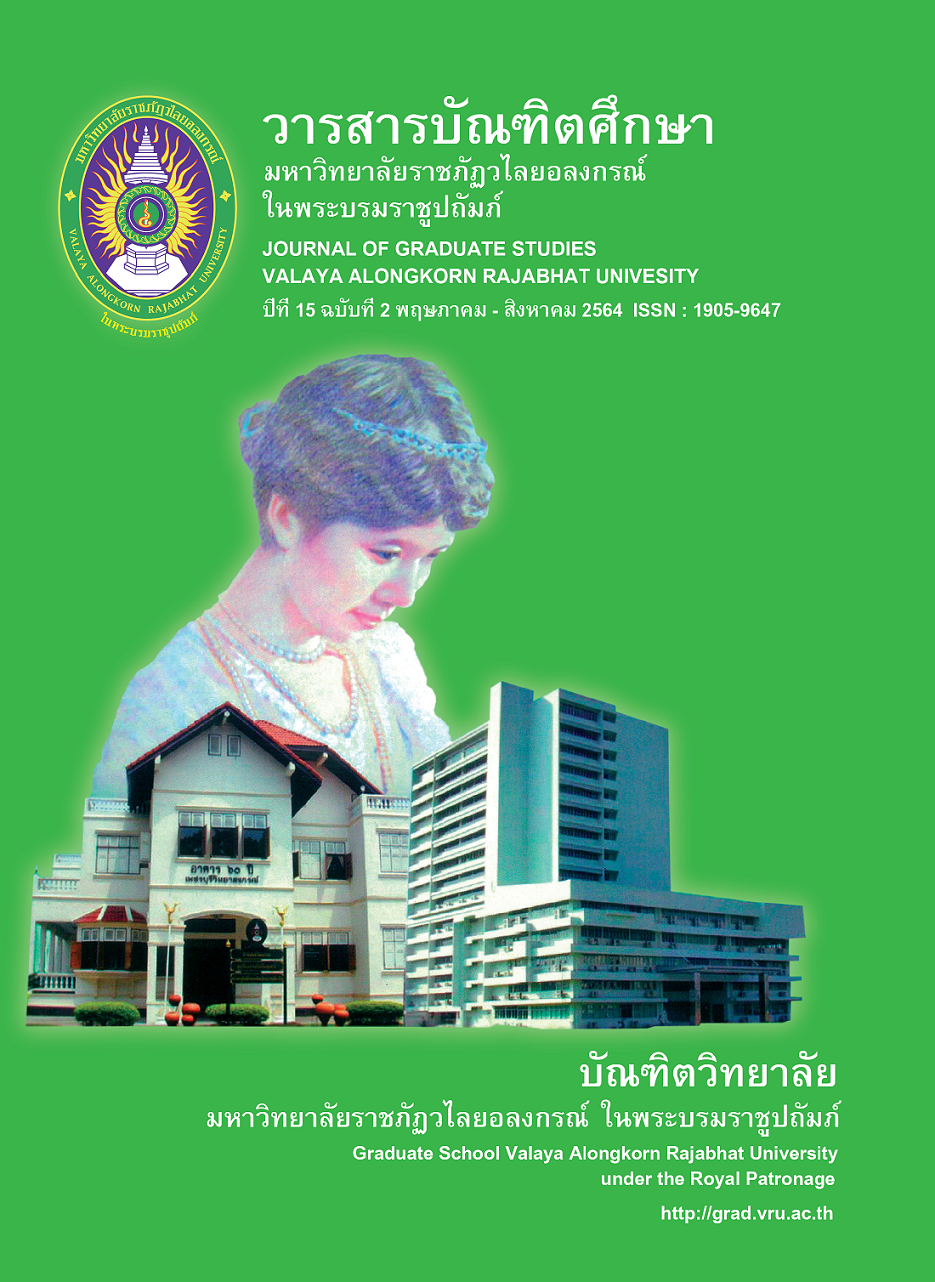AN CLASSROOM ACTION RESEARCH FOR PROMOTE ABILITIES IN GEOMETRIC PROOF OF GRADE 8 STUDENTS BY USING THE FIVE PRACTICES
Main Article Content
Abstract
This classroom action research was aimed to promote abilities in geometric proof by using the Five Practices to design and organize learning activities. The target group consisted of 42 grade 8 students at Chiang Mai University Demonstration School. They were chosen by purposive sampling. The research instruments included 9 lesson plans, post-instruction notes, worksheets, and 9 items subjective test on the student’s abilities in geometric proof that showed the discrimination ranged from 0.23 to 0.86, the difficulty ranged from 0.21 to 0.54 and the reliability was 0.93. The research was conducted along the 4 steps of continuous 3 cycles of classroom action research (PAOR) composed of Plan, Act, Observe and Reflect that used the Five Practices.
The findings reveal that the most students had geometric proof abilities from good level up to very good level, 64.29%. In which students were able to demonstrate geometric proof by referring to the definitions, axioms, and geometric theorems mostly correct and all.
Article Details

This work is licensed under a Creative Commons Attribution-NonCommercial-NoDerivatives 4.0 International License.
บทความทุกเรื่องได้รับการตรวจความถูกต้องทางวิชาการโดยผู้ทรงคุณวุฒิ ทรรศนะและข้อคิดเห็นในบทความ Journal of Global of Perspectives in Humanities and Social Sciences (J-GPHSS) มิใช่เป็นทรรศนะและความคิดของผู้จัดทำจึงมิใช่ความรับผิดชอบของบัณฑิตวิทยาลัย มหาวิทยาลัยราชภัฏวไลยอลงกรณ์ ในพระบรมราชูปถัมภ์ กองบรรณาธิการไม่สงวนสิทธิ์การคัดลอก แต่ให้อ้างอิงแหล่งที่มา
References
Brikshavana, T. (2017). kānsưksā khwāmsāmāt læ panhā nai kān phisūt thāng khanittasāt khō̜ng naksưksā laksūt sưksā sāttra bandit sākhā wichā khanittasāt mahāwitthayālai sūan Dusit [A Study of Ability and the Problems in Mathematical Proof of Educational Bachelor Degree Students, Mathematical Program, Suan Dusit University]. Journal of Multidisciplinary in Social Sciences, 13(2), 167-184.
Chaiyawong, T., & Kamol, N. (2018). kān songsœ̄m khwāmsāmāt nai kān kǣ panhā thāng khanittasāt khō̜ng nakrīan chan matthayommasưksā pī thī sō̜ng dōi chai hā nǣo patibatkān sō̜n [Promoting Mathematical Problem Solving Abilities of Grade 8 Students Using the Five Practices]. Proceeding of the 23rd Annual Meeting in Mathematics: AMM 2018 “Mathematical Science for Thailand 4.0” 3 – 5 May 2018.Mandarin Hotel Bangkok: 337–343.
Engle, R. A., & Conant, F. R. (2002). Guiding principles for fostering productive disciplinary engagement: Explaining an emergent argument in a community of learners classroom. Cognition and Instruction, 20(4), 399-483.
Goldberger, A. (2002). What are mathematical proofs and why they are important? Math 216 class, University of Connecticut.
Gutierrez, A., Pegg, J., & Lawrie, C. (2004). Characterization of Students' Reasoning and Proof Abilities in 3-Dimensional Geometry. International Group for the Psychology of Mathematics Education.
Hanna, G. (2000). Proof, explanation, and exploration: An overview. Educational studies in mathematics, 44(1-2), 5-23.
Henningsen, M., & Stein, M. K. (1997). Mathematical tasks and student cognition: Classroom-based factors that support and inhibit high-level mathematical thinking and reasoning. Journal for research in mathematics education,
-549.
Kemmis, S. and McTaggart, R. (1990). The Action Research Planner. Geelong: Deakin University Press.
Makanong, A. (2015). khrū khanittasāt samrap matthayommasưksā [Mathematics Teacher for Secondary School]. 2nd ed. Bangkok: Chulalongkorn University.
Martin, T. S., McCrone, S. M. S., Bower, M. L. W., & Dindyal, J. (2005). The interplay of teacher and student actions in the teaching and learning of geometric proof. Educational Studies in Mathematics, 60(1), 95-124.
Moothummachai, N., & Kamol, N. (2017). rūpbǣp kānchai ngān thāng khanittasāt thī songsœ̄m khwāmsāmāt nai kānhai hētphon thāng khanittasāt rư̄ang khwāmsamphan læ fangchan khō̜ng nakrīan chan matthayommasưksā pī thī sī [Using Mathematical Tasks Forms that Promoting Mathematical Reasoning Abilities in The Relationship and Function of Grade 10 Students].Proceeding of the 22nd Annual Meeting in Mathematics: AMM 2017 “Mathematics Research and National Research Strategy” 2 – 4 June 2017. Lotus Pang Suan Kaew Hotel Chiang Mai.
Richland, L. E., Begolli, K. N., Simms, N., Frausel, R. R., & Lyons, E. A. (2017). Supporting mathematical discussions: The roles of comparison and cognitive load. Educational Psychology Review, 29(1), 41-53.
Smith, M. S., & Stein, M. K. (2011). Five practices for orchestrating productive mathematics discussions. Reston, VA: National Council of Teachers of Mathematics.
Smith, M. S., Hughes, E. K., Engle, R. A., & Stein, M. K. (2009). Orchestrating discussions. Mathematics Teaching in the Middle School, 14(9): 548-556.
The Institute for the Promotion of Teaching Science and Technology. (2012). thaksa / krabūankān thāng khanittasāt [Skills/Mathematical Process]. 3rd ed. Bangkok: Kurusapa Printing Ladphrao.
The Institute for the Promotion of Teaching Science and Technology. (2019). khūmư̄ kānchai laksūt klum sāra kānrīanrū khanittasāt [Manual for curriculum in mathematics]. Retrieved from https://www.scimath.org/ebook-mathematics/item/8380-2560-2551-8380
Weikle, D. A., & Murray, M. (2014). Improving CS class discussions using the 5 practices. Journal of Computing Sciences in Colleges, 29(3), 65-71.
Wongwanich, S. (2016). kānwičhai patibatkān nai chan rīan [Classroom Action Research]. 18th ed. Bangkok: Chulalongkorn University.


